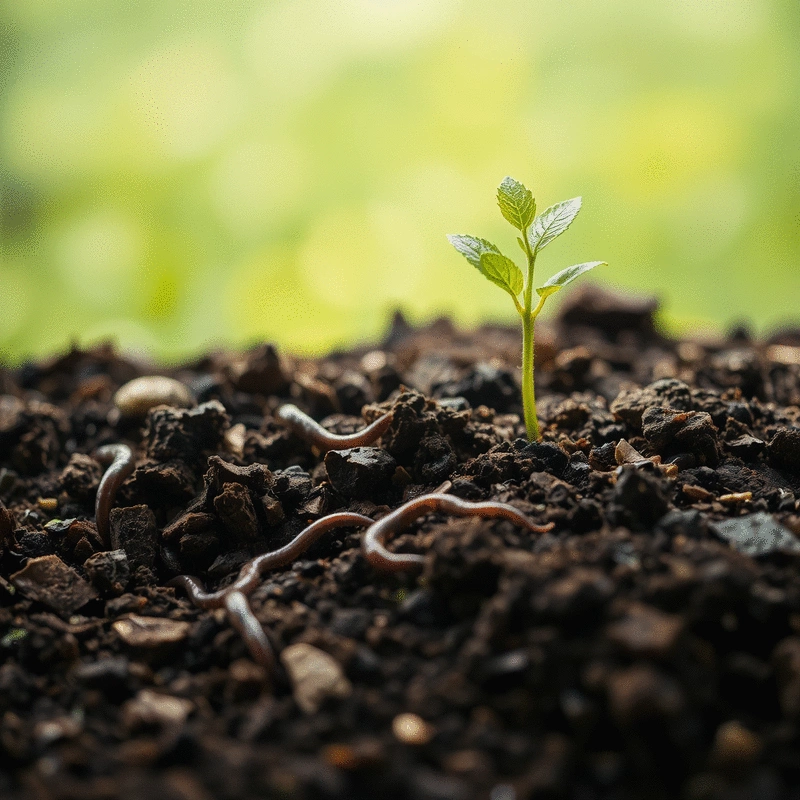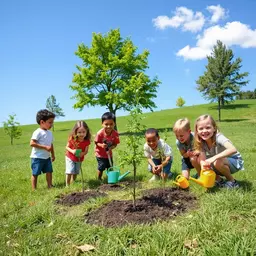Soil Health for Sustainable Tree Planting

Did you know that healthy soil is the hidden champion behind thriving ecosystems? The role of soil health in eco-friendly tree planting is not just crucial; it's foundational. This article dives deep into how nurturing the earth beneath our feet can lead to sustainable tree growth and a healthier planet.
Key Takeaways
- Soil health is defined by biological activity, nutrient availability, and physical structure, which are essential for supporting plant growth.
- Prioritizing soil health leads to stronger root systems, reduced need for chemical fertilizers, and improved resilience against pests and diseases.
- Key soil health indicators include soil pH, organic matter content, and microbial activity, which help assess soil vitality.
- Implementing sustainable practices like cover cropping and contour planting can prevent soil erosion and enhance tree growth.
- Organic methods for restoring soil fertility, such as composting and engaging community workshops, contribute to a healthier ecosystem.
- The soil food web, consisting of microorganisms, fungi, and earthworms, plays a critical role in nutrient cycling and tree health.
- Maintaining soil structure is vital for moisture retention, which is crucial for tree survival during dry periods.
- Healthy soils capture carbon dioxide, thereby playing a significant role in climate regulation and combating climate change.
- Custom soil amendment plans tailored to specific tree species can significantly improve growth outcomes.
- Community engagement and education are key to promoting soil health initiatives that foster a culture of sustainability.
Impact of Soil Health on Tree Growth and Ecosystems
Understanding the relationship between soil health and effective tree planting is crucial. Here are key indicators and benefits of maintaining soil health:
Soil Health Indicators
- Soil pH: Affects nutrient availability
- Organic Matter Content: Higher values indicate better health
- Microbial Activity: Active microorganisms signify healthy soil
Benefits of Healthy Soil
- Stronger root systems for nutrient access
- Reduced need for chemical fertilizers
- Enhanced resilience against pests and diseases
Soil Conservation Practices
- Using cover crops to protect soil
- Implementing contour planting
- Creating buffer zones to absorb excess water
Economic Benefits of Soil Health
- Lower long-term costs for tree care
- Grants and subsidies for sustainable practices
- Improved timber and fruit yield
The Essential Role of Soil Health in Eco-Friendly Tree Planting
When we think about planting trees, we often picture the saplings reaching for the sky. However, the *foundation* of successful tree planting lies beneath our feet—in the health of the soil. Understanding soil health is crucial not only for tree growth but also for the overall vitality of our ecosystems. After all, a thriving tree begins with a thriving soil! It’s something that I, Celia Greenwood, am deeply passionate about at Timber & Thrive. You can learn more about nurturing trees for healthier growth on our blog.
Understanding Soil Health and Its Impact on Ecosystems
Defining Soil Health: Key Concepts and Attributes
Soil health can be defined by its ability to sustain plant and animal life while providing essential ecosystem services. Some key concepts include:
- Biological activity: This includes the presence of microorganisms, fungi, and other organisms that contribute to soil fertility.
- Nutrient availability: Healthy soil should provide the necessary nutrients to support plant growth.
- Physical structure: A well-structured soil allows for proper drainage and air circulation, both vital for root development.
In essence, healthy soil is alive! It hosts a community of organisms that help trees and plants thrive, making it a critical factor in our eco-friendly tree planting initiatives.
The Link Between Soil Health and Sustainable Tree Planting Practices
By prioritizing soil health, we create a solid foundation for sustainable tree planting practices. Healthy soil leads to:
- Stronger root systems that can access more nutrients and water.
- A reduced need for chemical fertilizers, promoting an eco-friendly approach.
- Enhanced resilience against pests and diseases.
At Timber & Thrive, we believe that nurturing our soil is just as important as the trees we plant. When we take care of the soil, we help create a robust environment for trees to flourish! Discover more about sustainable urban tree care tips to further enhance your planting efforts.
Soil Health Indicators: Measuring Vital Signs of Soil
To evaluate soil health, it’s essential to monitor specific indicators. These indicators can help us understand the vitality of our soil and inform our planting strategies. Some vital signs include:
- Soil pH: This affects nutrient availability and overall plant health.
- Organic matter content: Higher organic matter usually means better soil health.
- Microbial activity: Active microorganisms indicate a lively and productive soil ecosystem.
By regularly assessing these indicators, we can ensure our planting efforts are based on the healthiest soil possible. It’s all part of the journey towards a greener future!
Soil Conservation as a Foundation for Tree Growth
Preventing Soil Erosion: Techniques for Sustainable Practices
Soil erosion poses a significant threat to tree growth and overall ecosystem health. To combat this, we can implement various sustainable practices, such as:
- Using cover crops to protect bare soil and enhance nutrients.
- Implementing contour planting techniques to minimize runoff.
- Creating buffer zones with vegetation to absorb excess water.
These techniques not only protect the soil but also create a nurturing environment for trees to grow strong and healthy. It’s a win-win for both the earth and us!
Restoring Soil Fertility: Organic Methods and Community Involvement
At Timber & Thrive, we advocate for organic methods to restore soil fertility. Some effective strategies include:
- Composting organic waste to enrich the soil.
- Incorporating green manures and cover crops to fix nitrogen levels.
- Encouraging community workshops to share knowledge on organic practices.
Engaging the community not only promotes sustainable practices but also fosters a sense of stewardship over our natural resources. Together, we can cultivate a healthier world! Learn more about organic fertilizers for healthier trees and how they contribute to soil fertility.
Erosion Control Practices: Protecting Soil Integrity
Protecting soil integrity is vital for promoting tree growth. Some effective erosion control practices include:
- Building terraces on slopes to slow down water flow.
- Planting native vegetation to stabilize soil.
- Utilizing erosion control blankets made from natural fibers.
By implementing these practices, we ensure that our soil remains intact and capable of supporting the trees we cherish.
The Importance of Soil Biology in Tree Longevity
Exploring the Soil Food Web: Microbes, Fungi, and Earthworms
The soil food web is a complex network of organisms that play a crucial role in tree health. Key players include:
- Microorganisms: These tiny life forms break down organic matter, releasing nutrients for tree roots.
- Fungi: They form symbiotic relationships with tree roots, enhancing nutrient uptake.
- Earthworms: Often called nature's tillers, they aerate the soil and contribute to its structure.
Understanding and nurturing this web of life helps us promote tree longevity and a sustainable ecosystem. The more we learn about these interactions, the better we can support our trees!
Maintaining Soil Structure for Enhanced Moisture Retention
Soil structure is fundamental for tree growth, particularly when it comes to moisture retention. Here are some practices we can adopt:
- Minimizing soil compaction through mindful planting.
- Incorporating organic matter to improve soil texture.
- Using mulch to reduce evaporation and maintain moisture levels.
When we focus on maintaining good soil structure, we set our trees up for success, helping them thrive in any environment.
The Role of Mycorrhizal Fungi in Tree Health
Mycorrhizal fungi form critical partnerships with tree roots, aiding in nutrient and water absorption. Their contributions can be summarized as follows:
- Enhancing nutrient uptake, particularly phosphorus.
- Improving soil structure, allowing roots to spread more easily.
- Increasing tree resilience to stress factors, such as drought.
By understanding the importance of these fungi, we can make more informed choices about our soil management strategies and ultimately support our trees’ health.
Climate Regulation through Effective Soil Management
Soil's Role in Water Retention: Mitigating Drought Stress
Healthy soil plays a crucial role in retaining water, helping trees survive during dry periods. Some effective practices include:
- Incorporating organic material to enhance water-holding capacity.
- Implementing rainwater harvesting strategies.
- Using cover crops to improve soil structure and moisture retention.
By focusing on these practices, we can help mitigate drought stress and ensure a sustainable environment for our trees to thrive.
Carbon Sequestration: How Healthy Soil Contributes to Climate Stability
Soil health is vital for carbon sequestration, helping combat climate change. Here are some key points:
- Healthy soils capture carbon dioxide from the atmosphere.
- Incorporating organic matter boosts the soil's carbon storage capacity.
- Promoting diverse plant life enhances soil health and carbon retention.
By understanding this connection, we can take action to improve soil health and contribute to climate stability. Every small effort counts!
Climate Change Mitigation through Sustainable Practices
Adopting sustainable soil management practices not only contributes to tree health but also plays a role in mitigating climate change. Some effective measures include:
- Practicing agroforestry to integrate trees into agricultural systems.
- Restoring degraded soils to enhance their ability to store carbon.
- Encouraging community initiatives focused on sustainable land use.
By working together, we can tackle climate change while nurturing our forests and communities. Let’s make a difference, one tree at a time!
Innovative Soil Management Strategies for Different Tree Species
Custom Soil Amendment Plans: Tailoring to Specific Needs
Not all trees thrive in the same type of soil. Creating custom soil amendment plans can help address specific needs. Consider the following:
- Testing soil pH to determine necessary adjustments.
- Incorporating specific nutrients based on tree species requirements.
- Utilizing organic matter that caters to the local ecosystem.
By tailoring our approach, we can ensure that each tree has the best chance at thriving, making our planting efforts more effective.
Soil Testing Methods: Assessing Soil Health for Tree Planting
Regular soil testing is essential for assessing soil health. Here are some methods to consider:
- Conducting a simple home soil test kit to check pH levels.
- Sending samples to a local lab for detailed nutrient analysis.
- Monitoring soil moisture levels to gauge health over time.
Understanding our soil’s unique characteristics helps us make informed decisions about tree planting and care!
Utilizing Cover Crops to Enhance Soil Quality
Cover crops are an excellent way to improve soil quality and support tree health. Some benefits include:
- Reducing soil erosion during off-seasons.
- Enhancing nutrient availability for future tree plantings.
- Providing habitat for beneficial organisms.
By incorporating cover crops into our planting strategies, we can foster healthier soil ecosystems, ensuring a brighter future for our forests.
Case Studies in Eco-Friendly Tree Planting Success
Documented Improvements in Soil Health and Tree Growth
There are numerous success stories that demonstrate the impact of prioritizing soil health in tree planting. For instance:
- Local initiatives that have restored degraded land through community planting efforts.
- Documented increases in tree growth rates when soil health is actively managed.
- Successful restoration projects that have improved biodiversity by enhancing soil conditions.
These real-life examples remind us of the *power* of healthy soil and informed practices, encouraging us to continue our journey towards a greener future! Explore more about starting a community tree project to see how collective action can make a difference.
Community Engagement Models Supporting Soil Health Initiatives
Engaging the community is vital in promoting soil health initiatives. Some effective models include:
- Organizing local workshops to share knowledge about soil management.
- Collaborating with schools to incorporate tree planting into educational curricula.
- Creating volunteer programs to involve community members in restoration projects.
At Timber & Thrive, we believe that community involvement is a key driver of change, and together, we can foster a love for trees and soil health!
Success Stories of Agroforestry and Ecological Restoration
Agroforestry and ecological restoration projects have shown remarkable success in enhancing soil health and tree growth. Highlighted successes include:
- Farmers integrating trees into their crops for improved yields and biodiversity.
- Restoration projects led by local groups that have revitalized degraded landscapes.
- Successful partnerships between organizations that promote soil and tree health.
These achievements inspire hope and demonstrate that nurturing our soil and trees can create a sustainable future for all. Together, we can make a lasting impact!
Pro Tip
Did you know? Integrating cover crops between tree plantings can significantly improve soil health! These crops not only prevent erosion but also enhance nutrient availability and support beneficial microorganisms. By utilizing cover crops, you can create a thriving environment for your trees while promoting overall soil vitality.
Long-Term Benefits of Prioritizing Soil Health in Tree Planting
When we talk about eco-friendly tree planting, one of the most significant aspects to consider is soil health. It's not just about putting a tree in the ground; it’s about creating a thriving ecosystem! Prioritizing soil health brings numerous long-term benefits that extend beyond the trees themselves, positively impacting our communities and economies. Here, we will explore how emphasizing soil health can lead to sustainable practices that benefit everyone.
Economic and Policy Perspectives on Soil Health Practices
Investing in sustainable soil management practices can actually save money in the long run! There are financial incentives available for individuals and organizations that prioritize soil health. These incentives often come in the form of grants, tax breaks, or subsidies designed to encourage eco-friendly practices. By harnessing these resources, we can make tree planting not only environmentally friendly but economically viable as well.
Additionally, local and regional policies play a crucial role in promoting soil health. Governments are starting to recognize the importance of healthy soil in combating climate change and supporting agriculture. By advocating for policies that protect and enhance soil quality, we can create a supportive environment for sustainable tree planting initiatives. Here are some examples of policies that help foster soil health:
- Incentives for organic farming practices
- Regulations against harmful chemicals
- Grants for community-led conservation projects
Ultimately, focusing on environmental stewardship translates to economic value. Healthy soils lead to thriving trees, which can provide resources like timber and fruits. Investing in soil health is like investing in our future!
Summarizing the Importance of Soil Health in Eco-Friendly Tree Planting
Soil health is a cornerstone of sustainable practices, and understanding its importance is essential for everyone involved in tree planting. Let’s summarize the key takeaways that highlight how we can make a difference:
- Healthy soil enhances tree growth and resilience.
- Improved soil quality supports biodiversity, leading to richer ecosystems.
- Community involvement is crucial for successful soil conservation initiatives.
Engaging with local communities fosters a sense of responsibility and connection to the land. When we work together, we can create a culture of sustainability around tree planting and soil health. It’s all about recognizing that we’re interconnected, and our actions today will shape the environment for future generations.
Frequently Asked Questions about Soil Health and Tree Planting
Curious about how to maintain soil health? Many people wonder about the best practices that can lead to thriving trees and healthy ecosystems. Here are some frequently asked questions that can help guide your journey:
- What are the best practices for maintaining soil health? Regular testing, the use of cover crops, and organic amendments are all effective strategies.
- How does soil health affect tree growth and biodiversity? Healthy soil supports diverse microorganisms that foster tree growth and nutrient uptake.
- What is the role of organic matter in soil fertility? Organic matter enhances soil structure, moisture retention, and provides essential nutrients for plants.
- How can community engagement promote soil health? Community workshops, volunteer programs, and educational initiatives foster stewardship and knowledge sharing.
- What is the impact of soil health on climate change? Healthy soil contributes to carbon sequestration and water retention, mitigating drought stress and climate instability.
As we continue our efforts at Timber & Thrive, I encourage you to explore these questions further. Every step we take towards understanding and improving soil health is a step towards a more sustainable and vibrant future!
Recap of Key Points
Here is a quick recap of the important points discussed in the article:
- Soil Health is Fundamental: Healthy soil is essential for supporting tree growth and overall ecosystem vitality.
- Indicators of Soil Health: Monitor soil pH, organic matter content, and microbial activity to assess soil vitality.
- Sustainable Practices: Implement erosion control, organic methods, and community engagement for effective soil conservation.
- Soil Biology Matters: The soil food web, including microorganisms and mycorrhizal fungi, plays a crucial role in tree health.
- Climate Benefits: Healthy soils support carbon sequestration and water retention, helping to mitigate climate change impacts.
- Custom Soil Management: Tailor soil amendment plans and utilize cover crops to enhance soil quality for specific tree species.
- Community Involvement: Engaging local communities fosters stewardship and enhances the effectiveness of soil health initiatives.



